Black-capped foliage-gleaner
| Black-capped foliage-gleaner | |
|---|---|

| |
| at Registro, São Paulo State, Brazil | |
| Scientific classification | |
| Domain: | Eukaryota |
| Kingdom: | Animalia |
| Phylum: | Chordata |
| Class: | Aves |
| Order: | Passeriformes |
| Family: | Furnariidae |
| Genus: | Philydor |
| Species: | P. atricapillus
|
| Binomial name | |
| Philydor atricapillus (Wied, 1821)
| |
The black-capped foliage-gleaner (Philydor atricapillus) is a species of bird in the ovenbird family Furnariidae. The species is very closely related to the Alagoas foliage-gleaner and forms a superspecies with it. It is found in eastern Brazil, eastern Paraguay and far northeastern Argentina. They inhabit lowland rainforest and secondary forest from sea-level to 1,050 m (3,440 ft), and is not migratory.[2]
The black-capped foliage-gleaners is 16 to 17 cm (6.3–6.7 in) and weighs 17–27 g (0.60–0.95 oz). It has striking plumage for a foliage-gleaner, with a mostly rufous body and a black cap, and black and buff stripes through the eyes. The sexes are alike.[2]
It feeds on arthropods, preferring caterpillars and to a lesser extent beetles, but also takes flies, spiders, grasshoppers, true bugs, centipedes, and cockroaches. It feeds singly, in pairs or in mixed species feeding-flocks, and takes prey from dead leaves from the forest-floor to the canopy. Almost nothing is known about its breeding behaviour, beyond its nest being reported to being in a hole in a dirt bank.[2]
The species is not considered threatened. Its range has decreased due to deforestation, but it is able to persist in small fragments of habitat.[2]
References
- ^ Template:IUCN
- ^ a b c d Remsen, J.V., Jr (2017). Black-capped Foliage-gleaner (Philydor atricapillus). In: del Hoyo, J., Elliott, A., Sargatal, J., Christie, D.A. & de Juana, E. (eds.). Handbook of the Birds of the World Alive. Lynx Edicions, Barcelona. (retrieved from http://www.hbw.com/node/56557 on 11 March 2017).

